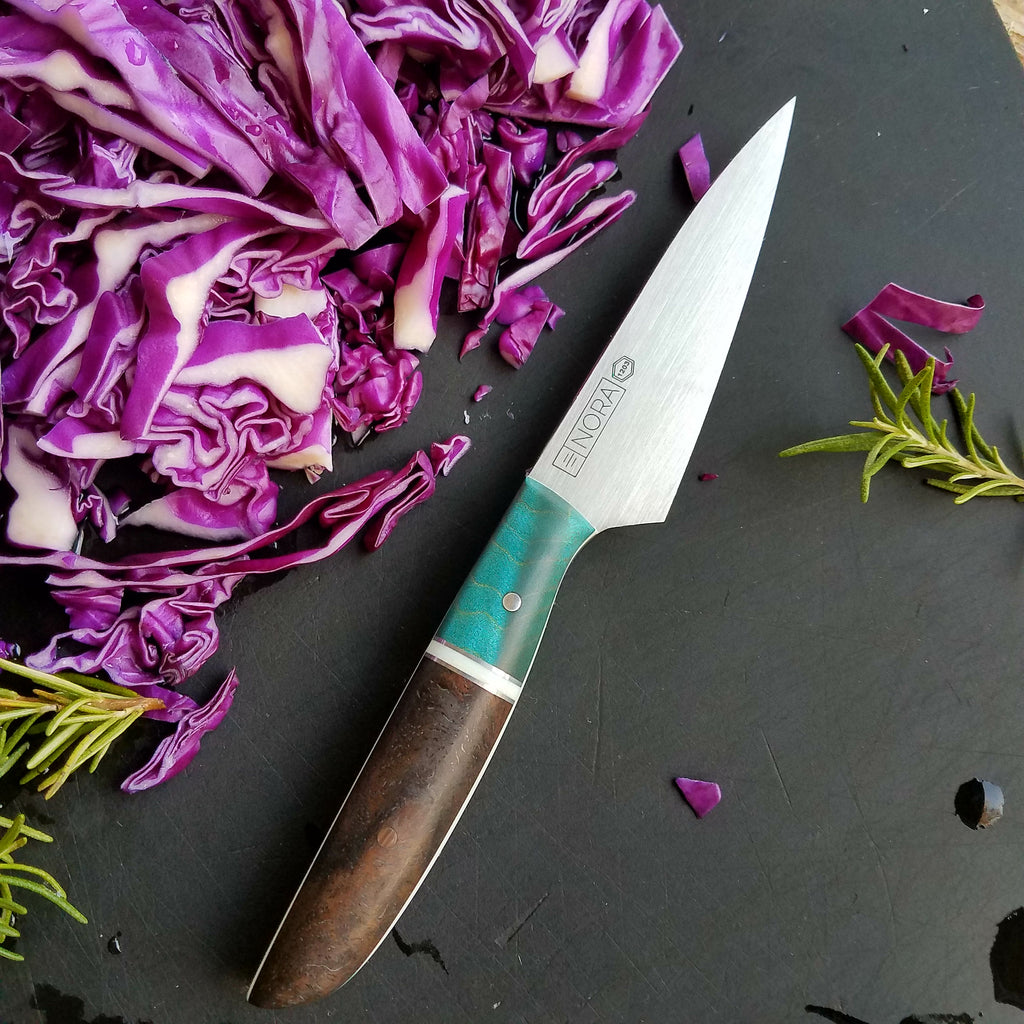

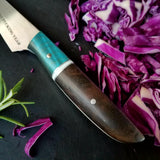
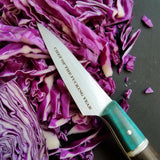
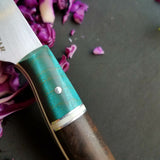

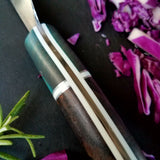
NORA #1203 - 3.5' Paring - Chef of the F*@cking Year
$ 214.00
**WARNING: THIS KNIFE HAS FOUL AND DIRTY LANGUAGE ENGRAVED ON THE BLADE. THIS IS NOT ONE TO GIVE TO YOUR MOM (UNLESS SHE IS, INDEED, JUST THAT GOOD.) JUST A FAIR WARNING SO YOU DON'T PURCHASE AN ITEM YOU DID NOT WANT.**
KNIFE HIGHLIGHTS
- Blade Type: Paring
- Blade Length: 3.5 Inches
- Total Length: 8 Inches
- Handle Style: Western | Right or Left Hand Use
- Steel: AEB-L Stainless Steel
- Rockwell Hardness: 61 HRC
- Grind Type: Full Flat
- Handle Materials: Stabilized Maple (dyed teal blue), aluminum accents, White G10, Stabilized Walnut, Stainless Steel Pins
- Thin for Performance (best performance but also more delicate)
- >>>Thick for Durability (tough, built to last for heavier wear-n-tear)
- Mid-Range with Special Geometry (specially ground for food release and glide but blade is kept slightly thicker for durability)
- Heavy in Hand (hefty, durable)
- Light (nimble, maneuverable)
- >>> Not too heavy, not too light (Mid-Range Weight)
GENERAL USES OF THIS KNIFE
The paring knife is often overlooked but the truth is it is one of the single most-used knives in the kitchen. It is also unique with respect to where it is used...not just on a cutting board but also in hand.
With this in mind, we redesigned our paring knife to have a smaller, more nimble handle that feels great in hand and gives its user a wide amount of maneuverability. This knife works wonderfully for small tasks that are easier completed by using the knife in-hand, such as hulling a strawberry, paring fruit, or deveining shrimp.
STEEL INFORMATION: AEB-L STAINLESS
This knife blade is composed of AEB-L stainless steel which is a high-quality Swedish metal, originally developed for razor blades. Recently, steel suppliers have made this steel available in thicker sheets and it has proven to be an excellent adaptation for the cutlery industry.
AEB-L has a beautiful balance of carbon and chromium and, with proper heat treatment, this steel produces both a very fine edge as well as excellent toughness and edge stability. The fine grain structure also makes this steel very easy to sharpen. We believe it is one of the finest stainless steels available on the market today for use with kitchen knives.
As a side note, this steel responds beautifully to honing and if the knife is honed regularly it should need infrequent sharpening.
HANDLE DESIGN & MATERIAL INFORMATION
Every one of our knives is numbered, handmade and unique. This NORA knife, number #1203, has been handled with a beautiful mix of materials including a dark, swirled walnut as a base and accented near the blade with a small chunk of maple dyed teal blue. White G10 and aluminum serve as accents. Both woods have been stabilized for durability.
Wood stabilization is an added feature that we offer with our knives. Wood that is stabilized has been injected with a clear acrylic resin under a vacuum process. Stabilization helps to minimize, if not eliminate, any cracking, warping, shrinkage and/or expanding of the material. Stabilized wood will not absorb water and is generally impervious to oils. The process helps to ensure your knife has a long lifespan in the kitchen.
As the cherry on top we added the engraving "Chef of the Fucking Year" on to the blade. Why? Someone needed to state the obvious and it may as well have been us. Your welcome. (Its like we know you or something. )
**This knife has been custom engraved. The engraving was done via laser so there is depth to the engraving more so than you see with an electro etch. We do, however, keep the depth minimal so it does not catch food and minimally interferes with the primary cutting function of the knife. A small amount of sticking is normal around the engraved area. The engraving should last as long as the knife but please note that it will slightly degrade over time as abrasives are used on the knife. We recommend the soft end of a sponge with soap and water for cleaning and mineral oil periodically to condition the blade (and handle). Keep in mind that stronger abrasives, such as steel wool, scotch brite pads, sand paper or stone sharpening directly on the engraved image will further degrade the image.
